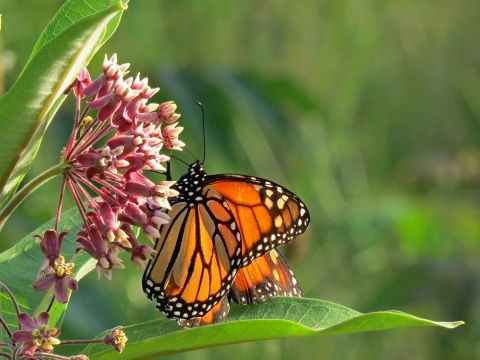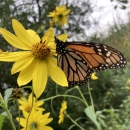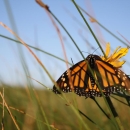In December 2020, after an extensive status assessment of the monarch butterfly, U.S. Fish and Wildlife Service (USFWS) determined that listing the monarch under the Endangered Species Act is warranted but precluded at this time by higher priority listing actions. With this finding, the monarch butterfly becomes a candidate for listing. Although there are generally no section 7 requirements for candidate species, we encourage all agencies to take advantage of any opportunity they may have to help conserve the species.
Voluntary Best Management
The monarch is found in open habitats state-wide in Alabama and relies heavily on a variety of native milkweed species and nectar producing plants. Recommended but voluntary conservation measures include:
Planting (recommended) or seeding of native milkweed and native nectar plants (organically grown Alabama sourced plants are best); with an aim for diversity of species and bloom timing;
Brush removal to promote habitat for native milkweed and native nectar-producing plants;
Targeted hardwood control when thinning woodlands on timber lands and selecting herbicides that preserve the herbaceous layer of plants when doing soil prep;
Prescribed burning (outside the growing season for native milkweeds; in patches or smaller units is recommended) to promote suitable habitat on a 2-3 year rotation in the Piedmont, 2 year rotation on the coastal plain, and 3-5 year rotation in the mountains;
Creating or preserving suitable habitat on idle lands or set-asides (see link below for additional guidance);
Conservation mowing (i.e. mowing only November – March) to enhance native floral resource habitat;
Targeted herbicide treatments (outside the growing season of native milkweeds) to restore suitable habitat;
Invasive species management.
Common Name | Scientific Name | Habitat | Location |
Butterfly Milkweed | Asclepias tuberosa | Well-drained soil, full sun, drought tolerant, mesic to dry forests, sandhills, prairies, and roadsides. | Throughout Alabama |
Western Swamp Milkweed | Asclepias incarnata | Tolerates some shade, stream banks, swamps, and wet roadside ditches. | North Alabama |
White Milkweed | Asclepias variegata | Dry pine or mixed pine/hardwood forests, and roadsides. | Throughout Alabama |
Green Milkweed | Asclepias viridis | Prairies, pastures, and roadsides. Usually basic soils. Requires full sun and a clay soil. Drought tolerant and deer resistant. | Black Belt region of central Alabama, the Tennessee Valley, and other areas underlain by limestone. |
Pinewoods Milkweed | Asclepias humistrata | Sandhills, on dunes, in scrub oak woods, and in xeric longleaf pine forests. | Southern half of Alabama |
Common Milkweed | Asclepias syriaca | Fields, pastures, and roadsides | Northeast Alabama |
Eastern Whorled Milkweed | Asclepias verticillata | Sandhills, prairies, chalk outcrops, cedar glades, and in dry, open woods. Full or partial sun. | Throughout Alabama |
Swamp Forest Milkweed/Aquatic Milkweed | Asclepias perennis | Swamps, floodplain forests, along creeks and streams, and around beaver ponds. Will even grow in shallow standing water. Can be used in bog gardens, shallow pools, and along streams or ponds. | Southern two-thirds of Alabama |
Four Leaf Milkweed | Asclepias quadrifolia | Hardwood forests, forest edges, and roadsides. Easily grown in dry to medium moisture, well- drained soils in full sun. Tolerates part shade. Best in sunny locations with sandy loams. Drought tolerant. | Mostly northeastern Alabama |
Carolina Milkweed | Asclepiascinerea | Sandhills, flatwoods, bogs, and pine-scrub oak ridges | Throughout Alabama |
Clasping Milkweed | Asclepias amplexicaulis | Dry prairies, savannas, open woods, and fallow fields | Throughout Alabama |
Fewflower Milkweed | Asclepias lanceolata | Fresh to brackish marshes; wet pinelands | Southern Alabama |
Green Comet Milkweed | Asclepias viridiflora | Openings in upland forests that are rocky or sandy, upland prairies, sand prairies, limestone glades; high quality habitats | Central Alabama |
Largeflower Milkweed | Asclepias connivens | Savannas, bogs, and flatwoods | Throughout Alabama |
Longleaf Milkweed | Asclepias longifolia | Swamps, savannas, flatwoods, and low pinelands | Southern Alabama |
Michaux’s Milkweed | Asclepias michauxii | Dry, sandy pine woods | Southern Alabama |
Poke Milkweed | Asclepias exaltata | Edges of forests, shores, woodlands | Northern Alabama |
Pineland Milkweed | Asclepias obovata | Sandy soils in pine and oak woods; occasionally in field and on roadsides | Southern Alabama |
Red Milkweed | Asclepias rubra | Bogs and marshy area in meadows and pine barrens; useful for wetland gardens or landscapes with permanently moist soils | Southern Alabama |
Tall Green Milkweed | Asclepias hirtella | Prairies, old fields, barrens, and glades | East-central Alabama |
Tuba Milkweed | Asclepias tomentosa | Naturally open sandy savannas | Southern Alabama |
Rolfs’ Milkweed | Asclepias tuberosa L. ssp. rolfsii | A subspecies of Butterfly Milkweed | Throughout Alabama |
Gulf Coast Swallow Wort | Pattalias palustre | Produces monarch- attracting foliage early; dunes, salt marshes, and coastal hammocks | Southern Alabama |
Bluevine | Ampelamus albidus or Cynanchum laeve | Streambanks, floodplains, and roadsides; prefers full or partial sun and a clay soil; requires a trellis or other support to climb on. | Throughout Alabama |
Sources:https://alabama.butterflyatlas.usf.edu/species/details/47 https://www.growmilkweedplants.com/alabama.html https://www.wildflower.org/plants/result.php?id_plant=ASQU https://plants.usda.gov/home/ http://floraofalabama.org/Plant.aspx?id=472





